10. The Brazen Bull
 The Brazen Bull was a hollow brass statue crafted to resemble a real bull. Victims were placed inside, usually with their tongues cut out first. The door was shut, sealing them in. Fires would then be lit around the bull. As the victim succumbed to the searing heat inside, he would thrash about and scream in agony. The movements and sounds, muted by the bull’s mass, made the apparatus appear alive, the sounds inside like those of a real bull. This effect created additional amusement for the audience, and served the added benefit of distancing them from the brutality of the torture, since they couldn’t directly see the victim.Legend has it that this device was invented by a Greek named Perillus (Perilaus in some sources) for a tyrant named Phalaris of Agrigentum. Expecting a handsome reward for his creativity, Perillus instead became the first person placed inside the Brazen Bull. By some reports, Phalaris himself became an eventual victim of the bull when his subjects grew tired of his mistreatment
The Brazen Bull was a hollow brass statue crafted to resemble a real bull. Victims were placed inside, usually with their tongues cut out first. The door was shut, sealing them in. Fires would then be lit around the bull. As the victim succumbed to the searing heat inside, he would thrash about and scream in agony. The movements and sounds, muted by the bull’s mass, made the apparatus appear alive, the sounds inside like those of a real bull. This effect created additional amusement for the audience, and served the added benefit of distancing them from the brutality of the torture, since they couldn’t directly see the victim.Legend has it that this device was invented by a Greek named Perillus (Perilaus in some sources) for a tyrant named Phalaris of Agrigentum. Expecting a handsome reward for his creativity, Perillus instead became the first person placed inside the Brazen Bull. By some reports, Phalaris himself became an eventual victim of the bull when his subjects grew tired of his mistreatment
9. Thumbscrews
 Thumbscrews represent a very insidious form of torture. You weren’t likely to die from their use, but they created unendurable agony. The device consisted of three upright metal bars, between which the thumbs were placed. A wooden bar slid down along the metal bars, pressing the thumbs against the bottom. A screw pressed the wood bar downward, crushing the thumbs painfully. The thumbscrews were an elaboration of an earlier device known as the pilliwinks, which could crush all 10 fingers and resembled a nutcracker.
Thumbscrews represent a very insidious form of torture. You weren’t likely to die from their use, but they created unendurable agony. The device consisted of three upright metal bars, between which the thumbs were placed. A wooden bar slid down along the metal bars, pressing the thumbs against the bottom. A screw pressed the wood bar downward, crushing the thumbs painfully. The thumbscrews were an elaboration of an earlier device known as the pilliwinks, which could crush all 10 fingers and resembled a nutcracker.
Thumbscrews supposedly originated with the Russian army as a punishment for misbehaving soldiers. A Scottish man brought a set home with him and introduced them to the United Kingdom.
Up next, a very old and very familiar medieval torture device, plus some variations on a theme.
8. The Rack
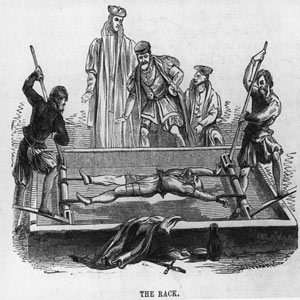 The rack was used throughout Europe for centuries. It came in many forms, but here’s the basic idea: The victim is tied down while some mechanical device, usually a crank or turning wheel, tightens the ropes, stretching the victim’s body until the joints are dislocated. Continued pressure could cause the limbs to be torn right off. Such torture was known as being “broken on the rack,” “racked,” or “stretched on the rack.” It could be combined with other forms of torture to make things even more painful. In one story, a Christian youth was tied to a wheel and his joints destroyed by the stretching. A fire was lit beneath the wheel, adding to the torture. Eventually, the fire was extinguished by the downpour of blood as the victim’s limbs were torn free.
The rack was used throughout Europe for centuries. It came in many forms, but here’s the basic idea: The victim is tied down while some mechanical device, usually a crank or turning wheel, tightens the ropes, stretching the victim’s body until the joints are dislocated. Continued pressure could cause the limbs to be torn right off. Such torture was known as being “broken on the rack,” “racked,” or “stretched on the rack.” It could be combined with other forms of torture to make things even more painful. In one story, a Christian youth was tied to a wheel and his joints destroyed by the stretching. A fire was lit beneath the wheel, adding to the torture. Eventually, the fire was extinguished by the downpour of blood as the victim’s limbs were torn free.
One type of rack was known as the Horse. It was a wooden device that vaguely resembled an actual horse in shape. The victim was tied to a beam on the top (the horse’s “back”), facing up. Pulleys below tightened ropes affixed to the victim’s hands and feet. He or she was stretched until his or her joints dislocated, then left there or slackened and allowed to hang underneath the horse while an inquisitor or judge questioned the victim and tried to get a confession. Torquemada, the infamous torturer of the Spanish Inquisition, was known to favor a stretching rack known as a potoro.
7. The Wheel
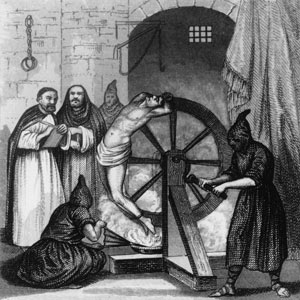 Wheels were adapted to many torturous uses. They could be part of a stretching rack, but medieval torturers were far too creative to leave it at that. Early torturers were fond of tying someone to a large wooden wheel, then pushing it down a rocky hillside. A more elaborate method involved a wheel mounted to an A-frame that allowed it to swing freely. The victim would be tied to the wheel, and then swung across some undesirable thing below — fire was always a good choice, but dragging the victim’s flesh across metal spikes also worked well. The wheel itself could also have spikes mounted on it, so the pain came from all directions. Instead of swinging, the wheel might turn on an axle. The difference was likely immaterial to the victims.
Wheels were adapted to many torturous uses. They could be part of a stretching rack, but medieval torturers were far too creative to leave it at that. Early torturers were fond of tying someone to a large wooden wheel, then pushing it down a rocky hillside. A more elaborate method involved a wheel mounted to an A-frame that allowed it to swing freely. The victim would be tied to the wheel, and then swung across some undesirable thing below — fire was always a good choice, but dragging the victim’s flesh across metal spikes also worked well. The wheel itself could also have spikes mounted on it, so the pain came from all directions. Instead of swinging, the wheel might turn on an axle. The difference was likely immaterial to the victims.
One of the most horrible wheel tortures was akin to crucifixion. The victim would have the bones in all four limbs broken in two places by strikes from an iron bar. Then, the shattered limbs were threaded through the spokes of a large wheel. Finally, the wheel would be attached to the top of a tall wooden pole and left out in the sun for days. The victim might be alive for hours, enduring the agony of his or her mangled arms and legs and the relentless sun, not to mention the attentions of crows.
Next, we’ll learn about two torture methods that were still used even after the Middle Ages had ended.
9. The Stake
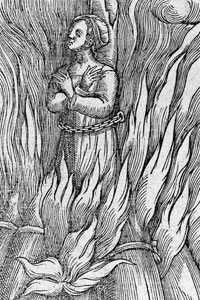 Being burned at the stake was usually the last stop for torture victims, because this form of torture was invariably fatal. Conceptually, it’s a very simple process — create a pile of dry wood with a stake at the center to tie the victim to, and then light it. The fire does all the work. It usually took about a half an hour before the victim lost consciousness, but if it was windy and the fire was blowing away from the victim, he or she might have to endure up to two hours of being slowly burned to death. Since the victims had usually been previously tortured with the rack or some other method, the pain must have been unimaginable. Despite the horror of simply being burned at the stake, the torturers of the Inquisition in the Netherlands developed a particularly cruel twist: Prior to being tied to the stake, the victim’s tongue would be sandwiched between two hot iron plates. The scorched and swollen tongue would only allow strange, muffled screams of pain once the burning began, which supposedly added a great deal to the audience’s entertainment.
Being burned at the stake was usually the last stop for torture victims, because this form of torture was invariably fatal. Conceptually, it’s a very simple process — create a pile of dry wood with a stake at the center to tie the victim to, and then light it. The fire does all the work. It usually took about a half an hour before the victim lost consciousness, but if it was windy and the fire was blowing away from the victim, he or she might have to endure up to two hours of being slowly burned to death. Since the victims had usually been previously tortured with the rack or some other method, the pain must have been unimaginable. Despite the horror of simply being burned at the stake, the torturers of the Inquisition in the Netherlands developed a particularly cruel twist: Prior to being tied to the stake, the victim’s tongue would be sandwiched between two hot iron plates. The scorched and swollen tongue would only allow strange, muffled screams of pain once the burning began, which supposedly added a great deal to the audience’s entertainment.
The cruel irony of the Inquisition’s practice of burning people at the stake was that it happened whether you confessed or not. Once accused of heresy, you would almost certainly be consumed by fire. However, if you confessed, you would be strangled to death before the fire was lit, supposedly sparing you the agony. This practice didn’t die out at the end of the Middle Ages, however. Both women and men accused of witchcraft were burned at the stake in England, France and other locales well into the 17th century.
5. The Pillory
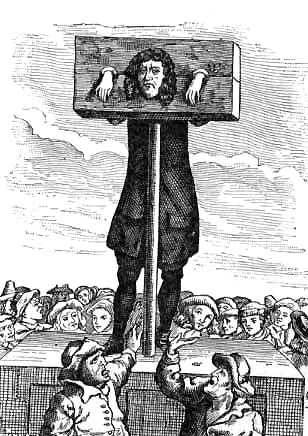 The pillory remained in use even later than the stake. A pillory is a set of two parallel wooden boards clasped together, with holes for the neck and wrists. When opened, the victim places his or her head and arms through the holes. Then the pillory is closed, and the victim can’t possibly escape.
The pillory remained in use even later than the stake. A pillory is a set of two parallel wooden boards clasped together, with holes for the neck and wrists. When opened, the victim places his or her head and arms through the holes. Then the pillory is closed, and the victim can’t possibly escape.
The pillory itself does no harm to the victim, though it’s certainly not comfortable. The entire apparatus was usually placed on a stage in a public place — the entire point was to humiliate and shame the victim for his or her crimes. The crowd would throw objects at the victim, such as rotten vegetables, dead animals or feces. Stones and other blunt objects were thrown as well, which could result in painful injuries or death.
While a spell in the pillory often only lasted an hour or two, usually during the busiest times of day, its effect really depended on the nature of the crime and the mood of the crowd. Four English men who had falsely accused others of crimes to get the reward (sending innocents to the hangman’s noose) were beaten to death by the crowd. Others who won the crowd’s favor by refusing to pay unjust taxes or mocking government officials were showered with flowers or rescued from the pillory outright. For lesser crimes, the victim might instead be placed in stocks, leg irons that restrained the ankles. While the goal of public humiliation was the same, the stocks allowed victims to protect themselves from thrown objects.
Sometimes, the vengeful crowd was the least of the victim’s concerns. The pillory could be accompanied by other punishments, such as flogging or mutilation. British authorities favored branding the face with a mark of shame, such cutting off one or both ears, or slicing the nose lengthwise.
The next section features one of the most infamous torture devices of all time, plus its lesser known cousin.
4. The Iron Maiden
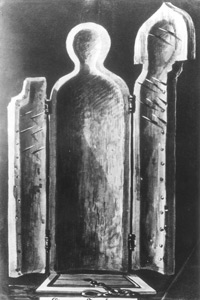 The Iron Maiden is a device so fiendish it was once thought to be fictional. It’s an upright sarcophagus with spikes on the inner surfaces. Double doors open on the front, allowing entrance for the victim. In one example, eight spikes protruded from one door, 13 from the other. Once the victim was inside, the doors were closed. There, the strategically placed spikes would pierce several vital organs. However, they were relatively short spikes, so the wounds wouldn’t be instantly fatal. Instead, the victim would linger and bleed to death over several hours. To add to the abject horror of it all, two spikes were positioned specifically to penetrate the.
The Iron Maiden is a device so fiendish it was once thought to be fictional. It’s an upright sarcophagus with spikes on the inner surfaces. Double doors open on the front, allowing entrance for the victim. In one example, eight spikes protruded from one door, 13 from the other. Once the victim was inside, the doors were closed. There, the strategically placed spikes would pierce several vital organs. However, they were relatively short spikes, so the wounds wouldn’t be instantly fatal. Instead, the victim would linger and bleed to death over several hours. To add to the abject horror of it all, two spikes were positioned specifically to penetrate the.
In the 1800s, researchers found one in a castle in Nuremberg, Germany, and documented proof of its use later surfaced. For this reason, this device is sometimes known as the Iron Maiden of Nuremberg. Other names included The Virgin and, in German, Jungfer. A variation found in Spain was made to look like the Virgin Mary, and had machinery that, when manipulated, caused her to “hug” the victim close to her spikes.
3. The Scavenger’s Daughter
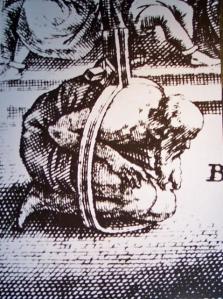 The Scavenger’s Daughter was invented by, and named after, a Brit named Skevington. It is alternately referred to as Skeffington’s gyves. The apparatus consists of a hoop of iron with a hinge in the middle. The victim was forced to crouch on one half of the hoop while the other half was pivoted and placed over his back. (Imagine being placed into a giant set of iron dentures.) The torturer would use a screw to tighten the hinge, crushing the victim further and further into his involuntary crouch. Eventually, ribs and breastbone would crack and the spine could be dislocated. Sometimes the compression was so great that blood would gush from the fingertips and face. Queen Elizabeth I of England used this tool against Protestants she accused of high treason.
The Scavenger’s Daughter was invented by, and named after, a Brit named Skevington. It is alternately referred to as Skeffington’s gyves. The apparatus consists of a hoop of iron with a hinge in the middle. The victim was forced to crouch on one half of the hoop while the other half was pivoted and placed over his back. (Imagine being placed into a giant set of iron dentures.) The torturer would use a screw to tighten the hinge, crushing the victim further and further into his involuntary crouch. Eventually, ribs and breastbone would crack and the spine could be dislocated. Sometimes the compression was so great that blood would gush from the fingertips and face. Queen Elizabeth I of England used this tool against Protestants she accused of high treason.
Next, we’ll finish up our torturous tour with a set of implements reserved for women.
2. The Breast Ripper
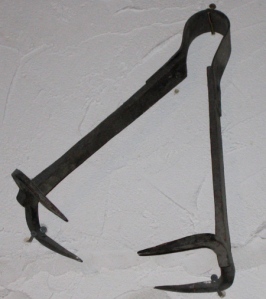 Torturers seemed to reserve special horrors for women. Surprisingly, few torturers had any reservations about torturing women — in fact, women-only tortures often seemed especially cruel and were designed to destroy specific aspects of femininity. In medieval England, differing torture practices were virtually codified: male criminals were hanged, while women faced the “drowning pits”.
Torturers seemed to reserve special horrors for women. Surprisingly, few torturers had any reservations about torturing women — in fact, women-only tortures often seemed especially cruel and were designed to destroy specific aspects of femininity. In medieval England, differing torture practices were virtually codified: male criminals were hanged, while women faced the “drowning pits”.
The practice of torturing women sexually extends back to Roman times (and surely even before then). Female victims were given to soldiers to be raped, or sent to brothels. They might be tied up or paraded through public streets naked. These public humiliations were sometimes followed by bizarre sexual mutilations. Torturers had a strange fixation on breasts, which were burned, branded or simply amputated. Worst of all was a device known as the Breast Ripper. It was a metal claw that pierced the flesh of the breast. The victim was tied to a wall, and then the claw pulled forcibly away, shredding the breast to pieces. It was used as both a method of punishment and interrogation — to mark the breasts of unmarried mothers and mutilate women convicted of heresy, adultery and a host of other crimes.
1. The Pear of Anguish
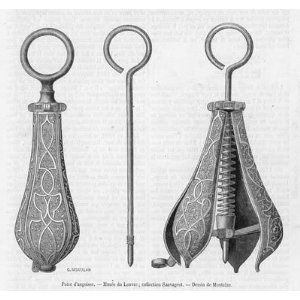 It’s unlikely, but if there could be anything worse than the Breast Ripper, it is surely the Pear of Anguish. This was a pear-shaped device, with the body of the pear made up of four metal “leaves” joined by a hinge at its top, and a key or crank on one end. The pear was inserted into the vagina, anus or throat, depending on the nature of the crime committed: The oral device was reserved for heretics, while the anal and vaginal pears were used on homosexuals and witches, respectively. Turning the key opened the leaves, causing massive internal damage . The device was rarely fatal, but other methods of torture would usually follow.
It’s unlikely, but if there could be anything worse than the Breast Ripper, it is surely the Pear of Anguish. This was a pear-shaped device, with the body of the pear made up of four metal “leaves” joined by a hinge at its top, and a key or crank on one end. The pear was inserted into the vagina, anus or throat, depending on the nature of the crime committed: The oral device was reserved for heretics, while the anal and vaginal pears were used on homosexuals and witches, respectively. Turning the key opened the leaves, causing massive internal damage . The device was rarely fatal, but other methods of torture would usually follow.
http://history.howstuffworks.com/middle-ages/10-medieval-torture-devices.htm
no!!!
tooo… disgusting
why put down medieval tortures since it happened back then and this is now nobody can use those devices any way but there is one thing you can do go online find the truth about these machines of torture and leave it alone
oh god. The breast ripper is probably a woman’s worst nightmare
ew